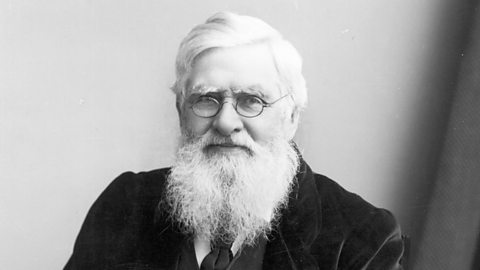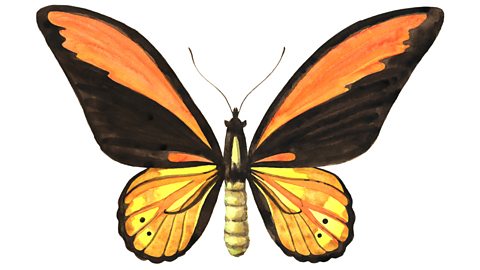Darwin and Wallace
Alfred Russel Wallace was a naturalist who independently proposed the theory of evolution by natural selection. A great admirer of Charles Darwin, Wallace produced scientific journals with Darwin in 1858, which prompted Darwin to publish On the Origin of Species the following year.


Wallace worked around the world gathering evidence to support his evolutionary theory. He is best known for studying warning colouration in animals, one example being the golden birdwing butterfly (Ornithoptera croesus), as well as his theory of speciationThe formation of new and distinct species in the course of evolution..
After a variety of zoological discoveries, Wallace proposed a theory of evolution which matched the unpublished ideas Darwin had kept secret for nearly 20 years. This encouraged Darwin to collect his scientific ideas and collaborate with Wallace. They published their scientific ideas jointly in 1858.
Principles of evolution by natural selection
The idea behind the theory of evolutionThe process of change in the inherited traits of a population of organisms from one generation to the next. through the process of natural selection is that all speciesUsed in the classification of living organisms, referring to related organisms capable of interbreeding and producing fertile offspring. of living things have evolved from simple life forms over a period of time. The Earth is about 4.5 billion years old, and there is scientific evidence to suggest that life on Earth began more than 3 billion years ago.
Natural selection
The accepted theory of evolution explains that it happens by natural selectionThe natural process whereby the best-adapted individuals survive longer, have more offspring and thereby spread their characteristics. Sometimes referred to as 'survival of the fittest'.. The key points are given below.
- Individuals in a species show a wide range of variationDifference between individuals of the same species. and this variation is a result of differences in their geneThe basic unit of genetic material inherited from our parents. A gene is a section of DNA which controls part of a cell's chemistry - particularly protein production. caused by random mutationA random and spontaneous change in the structure of a gene, chromosome or number of chromosomes. that can be inherited.
- In every population more offspring are produced than can survive. This overproduction leads to competition, eg for food.
- Individuals with characteristics most suited to their environment are more likely to survive and reproduce. This is commonly known as survival of the fittest. The genes that allow these individuals to be successful within their environment are passed on to their offspring, which results in these specific genes becoming more common.
- Individuals that are poorly adapted to their environment are less likely to survive and reproduce. Their genes are less likely to be passed on to the next generation.
- Over a period of time, a species will gradually evolve.
- Both genes and the environment can cause variation, but only genetic variation can be passed on to the next generation.
- If two populations of one species become increasingly different in phenotypeThe visible characteristics of an organism which occur as a result of its genes. that they can no longer interbreed to form fertile offspring, this can result in the formation of two species.
Modelling natural selection
This model can be used to demonstrate how natural selection can occur based on the characteristic of camouflage in a population of prey organisms.
Method
- Use a piece of green card as a background.
- Randomly place 20 green and 20 white pieces of string on the card to represent populations of prey organisms.
- Using a forceps to represent the mouth of the predator, collect as many pieces of string as you can in 10 seconds.
- Count how many green and white pieces are left and record.
- Repeat the process twice more.
Results of the model
This model shows that even though both species of prey are predated, the species with the highest degree of camouflage can survive. In reality, these organisms would be able to breed and pass on their camouflage genes. Where there was once an even distribution of green and white organisms, now the camouflaged organisms outnumber the non-camouflaged organisms by 10 to 1.
Limitations of the model
In this model the prey do not move. What if the white organisms were much faster than the green ones?
There may also be bias in the case of the predator. The scientist selecting the prey may do so not on the basis that some are easier to see, but on the basis that they were aware of what the results should be.
More guides on this topic
- Classification and biodiversity ÔÇô WJEC
- Cell division and stem cells ÔÇô WJEC
- DNA and inheritance ÔÇô WJEC
- Variation ÔÇô WJEC
- Mutation ÔÇô WJEC
- The nervous system ÔÇô WJEC
- Homeostasis ÔÇô WJEC
- The role of the kidneys in homeostasis ÔÇô WJEC
- Micro-organisms and their applications ÔÇô WJEC
- Disease, defence and treatment ÔÇô WJEC
- Video playlist